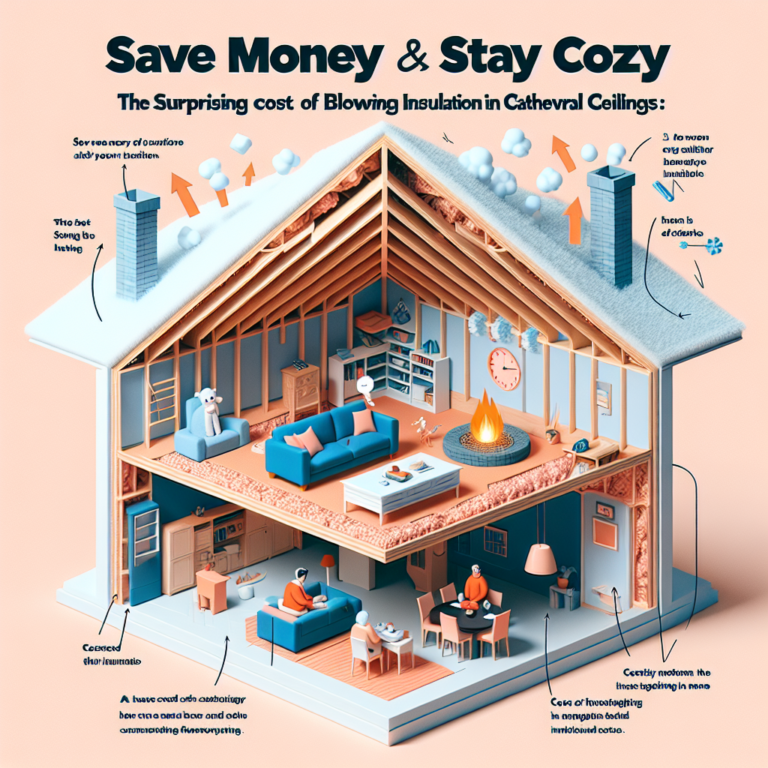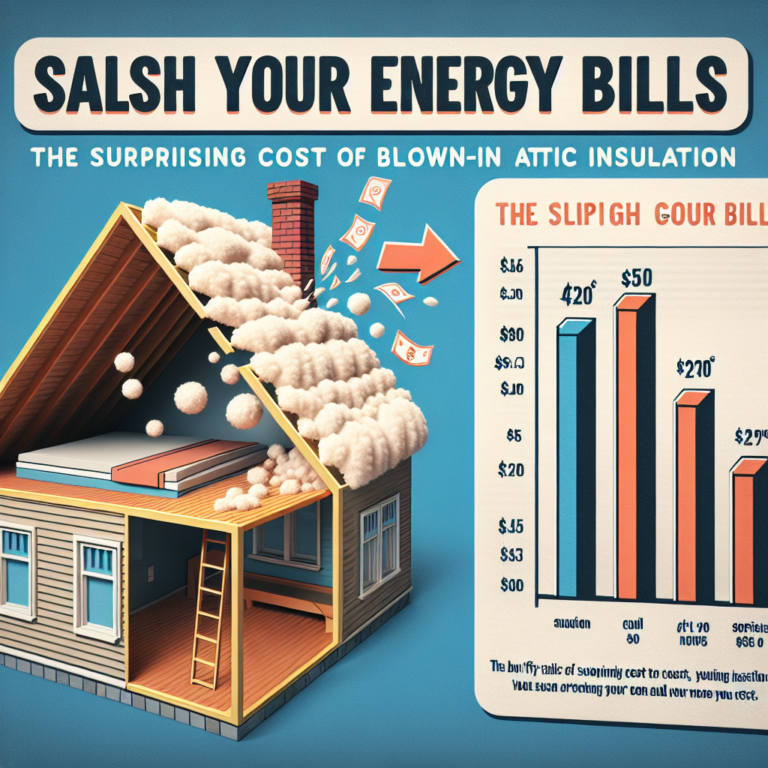-
Table of Contents
Insulate your home, save energy, and help save the planet with blown-in insulation.
“Join the movement to save energy and protect our planet by investing in blown-in insulation for your home. Not only will it reduce your energy consumption and lower your utility bills, but it will also help reduce carbon emissions and preserve our environment. Take action now and visit texasinsulationsolution.com to learn more about the benefits of blown-in insulation and schedule a consultation for your home.”
Introduction
Save Energy, Save the Planet: Blown-In Insulation for Your Home is a cost-effective and environmentally friendly solution for reducing energy consumption and minimizing your carbon footprint. By properly insulating your home with blown-in insulation, you can significantly decrease your energy bills and contribute to the preservation of our planet. In this article, we will explore the benefits of blown-in insulation and how it can help you save energy and protect the environment.
The Benefits of Blown-In Attic Insulation for Energy Efficiency
In today’s world, where climate change and environmental concerns are at the forefront of global discussions, it is more important than ever to make conscious efforts to reduce our carbon footprint. One of the most effective ways to do so is by making our homes more energy-efficient. Not only does this help the planet, but it also saves us money in the long run. One of the most efficient ways to improve energy efficiency in our homes is by using blown-in insulation in our attics.
Blown-in insulation, also known as loose-fill insulation, is a type of insulation that is made up of small particles of materials such as fiberglass, cellulose, or mineral wool. These particles are blown into the attic using specialized equipment, filling up any gaps and spaces to create a barrier against heat transfer. This method of insulation has gained popularity in recent years due to its numerous benefits, especially in terms of energy efficiency.
One of the main benefits of blown-in insulation is its ability to reduce energy consumption. Attics are one of the main areas of a home where heat loss occurs. Without proper insulation, warm air from inside the house can escape through the attic, causing the heating system to work harder to maintain a comfortable temperature. This results in higher energy bills and a larger carbon footprint. Blown-in insulation creates a thick layer of insulation in the attic, preventing heat from escaping and reducing the workload on the heating system. This, in turn, leads to lower energy bills and a more environmentally-friendly home.
Moreover, blown-in insulation is also known for its superior air sealing properties. Unlike traditional insulation methods, such as batt insulation, blown-in insulation can easily fill in small gaps and spaces, creating a more airtight seal. This prevents air leakage, which is a major cause of energy loss in homes. By sealing off these gaps, blown-in insulation helps to maintain a consistent temperature inside the house, reducing the need for heating or cooling. This not only saves energy but also makes the home more comfortable for its occupants.
Another advantage of blown-in insulation is its ability to resist moisture. Moisture can cause significant damage to a home’s structure and can also lead to mold growth, which can be harmful to one’s health. Blown-in insulation is made up of materials that are resistant to moisture, making it an ideal choice for attics. It creates a barrier against moisture, preventing it from seeping into the home and causing damage. This not only protects the home but also helps to maintain the efficiency of the insulation.
Furthermore, blown-in insulation is a more eco-friendly option compared to other insulation methods. The materials used in blown-in insulation are often made from recycled materials, reducing the need for new resources. Additionally, the process of blowing in the insulation is less labor-intensive, resulting in fewer emissions and a smaller carbon footprint. By choosing blown-in insulation, homeowners can contribute to a more sustainable future for the planet.
In conclusion, blown-in insulation offers numerous benefits for energy efficiency in homes. It reduces energy consumption, improves air sealing, resists moisture, and is a more eco-friendly option. By investing in blown-in insulation for your attic, you not only save money on energy bills but also play a part in protecting the planet. So, if you want to save energy and save the planet, consider blown-in insulation for your home.
How Blown-In Insulation Can Help Save the Planet
In today’s world, it is more important than ever to be conscious of our energy consumption and its impact on the environment. With the increasing threat of climate change, it is crucial that we take steps to reduce our carbon footprint and preserve our planet for future generations. One way to do this is by making our homes more energy-efficient, and blown-in insulation is a great option to achieve this goal.
Blown-in insulation, also known as loose-fill insulation, is a type of insulation that is installed by blowing or pouring it into the desired space. It is made up of small particles of materials such as fiberglass, cellulose, or mineral wool, which are blown into the walls, attic, or other areas of a home. This method of insulation is becoming increasingly popular due to its many benefits, including its positive impact on the environment.
One of the main ways blown-in insulation helps save the planet is by reducing energy consumption. According to the U.S. Department of Energy, heating and cooling account for nearly half of the energy used in a typical home. By properly insulating our homes, we can reduce the amount of energy needed to heat and cool them, resulting in lower energy bills and a reduced carbon footprint. Blown-in insulation is particularly effective in this regard because it fills in all the nooks and crannies of a space, creating a tight seal that prevents air from escaping. This means that less energy is needed to maintain a comfortable temperature inside the home, leading to significant energy savings.
Moreover, blown-in insulation is made from recycled materials, making it an environmentally friendly choice. Cellulose insulation, for example, is made from recycled paper products, while fiberglass insulation is made from recycled glass. By using these materials, we are reducing the amount of waste that ends up in landfills and conserving natural resources. Additionally, the production of blown-in insulation requires less energy compared to other types of insulation, further reducing its environmental impact.
Another way blown-in insulation helps save the planet is by reducing greenhouse gas emissions. As mentioned earlier, heating and cooling account for a significant portion of a home’s energy consumption. When we use less energy to heat and cool our homes, we are also reducing the amount of greenhouse gases, such as carbon dioxide, that are released into the atmosphere. These gases contribute to the greenhouse effect, trapping heat in the Earth’s atmosphere and causing global warming. By using blown-in insulation, we can help mitigate this effect and reduce our carbon footprint.
Furthermore, blown-in insulation can also help reduce our reliance on non-renewable energy sources. As the demand for energy continues to increase, it is essential to find alternative sources of energy that are sustainable and environmentally friendly. By reducing our energy consumption through proper insulation, we are also reducing our dependence on fossil fuels, which are a major contributor to climate change. This, in turn, helps to preserve our planet’s natural resources and reduce our impact on the environment.
In conclusion, blown-in insulation is an excellent option for homeowners looking to make their homes more energy-efficient and reduce their impact on the environment. Its ability to reduce energy consumption, use recycled materials, and reduce greenhouse gas emissions make it a sustainable choice for both the present and the future. By choosing blown-in insulation for our homes, we are not only saving energy and money, but we are also doing our part to save the planet.
Maximizing Energy Savings with Blown-In Attic Insulation
In today’s world, where climate change and environmental concerns are at the forefront of global discussions, it is more important than ever to find ways to reduce our carbon footprint and save energy. One of the most effective ways to do this is by properly insulating our homes. Not only does proper insulation help us save on energy bills, but it also plays a crucial role in reducing our impact on the planet. In this article, we will explore the benefits of blown-in attic insulation and how it can help maximize energy savings in your home.
First and foremost, let’s understand what blown-in insulation is. It is a type of insulation that is made up of loose fibers or particles, such as cellulose, fiberglass, or mineral wool, that are blown into the attic space using specialized equipment. This method of insulation is highly effective as it fills in all the nooks and crannies, creating a seamless barrier against heat transfer. This means that your home will stay warmer in the winter and cooler in the summer, without having to rely heavily on heating and cooling systems.
One of the main advantages of blown-in insulation is its ability to provide a higher R-value compared to traditional insulation methods. R-value is a measure of an insulation material’s resistance to heat flow, and the higher the R-value, the better the insulation. Blown-in insulation has a higher R-value per inch, making it a more efficient option for insulating your attic. This means that you can achieve the same level of insulation with less material, making it a cost-effective solution in the long run.
Moreover, blown-in insulation is also known for its ability to reduce air leakage. Air leakage occurs when there are gaps or cracks in the attic, allowing air to escape or enter the house. This can significantly impact the energy efficiency of your home, as it forces your heating and cooling systems to work harder to maintain a comfortable temperature. Blown-in insulation fills in these gaps, creating an airtight seal, and reducing air leakage. This not only helps save energy but also improves the overall comfort of your home.
Another benefit of blown-in insulation is its eco-friendliness. As mentioned earlier, blown-in insulation is made up of recycled materials, such as shredded newspaper or recycled glass. This means that it is a sustainable option for insulating your home, as it reduces the need for new materials to be produced. Additionally, blown-in insulation is also a great way to reduce your carbon footprint, as it helps reduce the amount of energy needed to heat or cool your home.
Furthermore, blown-in insulation is a quick and easy installation process. Unlike traditional insulation methods, which can be time-consuming and labor-intensive, blown-in insulation can be installed in a matter of hours. This means that you can start reaping the benefits of a well-insulated home in no time. Additionally, blown-in insulation can be installed over existing insulation, making it a convenient option for homeowners looking to upgrade their insulation without having to remove the old one.
In conclusion, blown-in attic insulation is a highly effective and efficient way to maximize energy savings in your home. Its ability to provide a higher R-value, reduce air leakage, and its eco-friendliness make it a top choice for homeowners looking to save energy and reduce their carbon footprint. So, if you want to do your part in saving the planet while also saving on energy bills, consider blown-in insulation for your home.
Q&A
1. What is blown-in insulation and how does it help save energy?
Blown-in insulation is a type of insulation made of loose fibers or particles that are blown into the walls, attic, or other areas of a home. It helps save energy by creating a barrier that prevents heat from escaping in the winter and entering in the summer, reducing the need for heating and cooling.
2. How does blown-in insulation contribute to saving the planet?
Blown-in insulation helps save the planet by reducing the amount of energy needed to heat and cool a home, which in turn reduces the amount of greenhouse gas emissions from power plants. It also helps conserve natural resources by reducing the need for non-renewable energy sources.
3. Are there any other benefits to using blown-in insulation besides energy savings?
Yes, there are several other benefits to using blown-in insulation. It can improve indoor air quality by reducing drafts and preventing moisture from entering the home. It also helps reduce noise pollution by acting as a sound barrier. Additionally, blown-in insulation is made from recycled materials, making it an environmentally friendly choice for homeowners.
Conclusion
In conclusion, blown-in insulation is a highly effective and eco-friendly solution for saving energy in your home. By properly insulating your home, you can reduce your energy consumption and carbon footprint, ultimately contributing to the preservation of our planet. With its easy installation and long-term cost savings, blown-in insulation is a practical and sustainable choice for homeowners looking to make a positive impact on the environment. By choosing to invest in blown-in insulation, you are not only saving energy, but also helping to save the planet.






